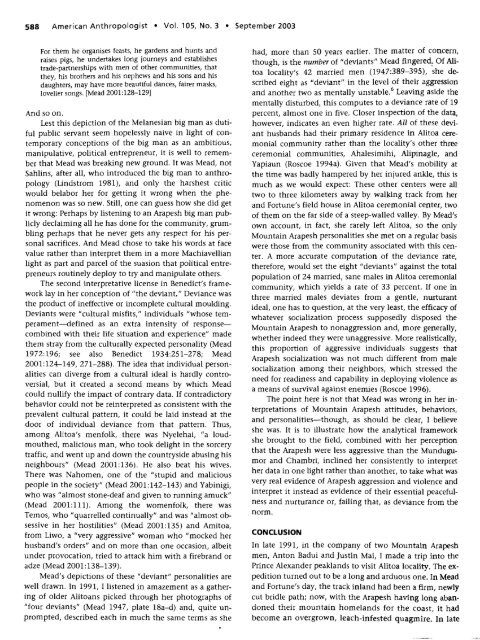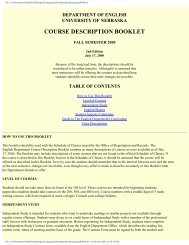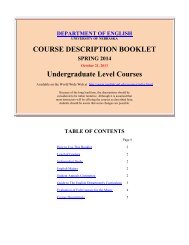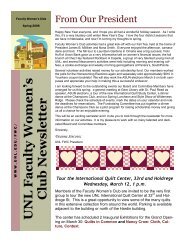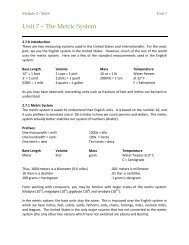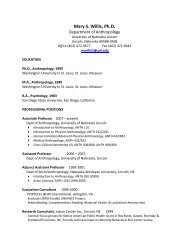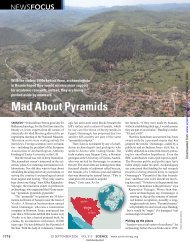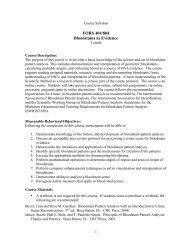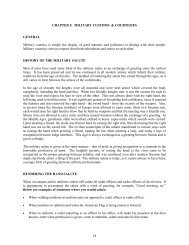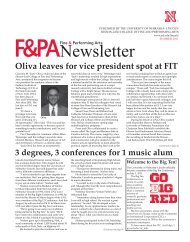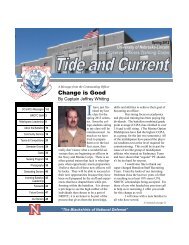Margaret Mead, Reo Fortune, and Mountain Arapesh Warfare
Margaret Mead, Reo Fortune, and Mountain Arapesh Warfare
Margaret Mead, Reo Fortune, and Mountain Arapesh Warfare
Create successful ePaper yourself
Turn your PDF publications into a flip-book with our unique Google optimized e-Paper software.
588 American Anthropologist • Vol. 105, No. 3 • September 2003<br />
For them he organises feasts, he gardens <strong>and</strong> hunts <strong>and</strong><br />
raises pigs, he undertakes long journeys <strong>and</strong> establishes<br />
trade-partnerships with men of other communities, that<br />
they, his brothers <strong>and</strong> his nephews <strong>and</strong> his sons <strong>and</strong> his<br />
daughters, may have more beautiful dances, fairer masks,<br />
lovelier songs. [<strong>Mead</strong> 2001:128-129]<br />
And so on.<br />
Lest this depiction of the Melanesian big man as dutiful<br />
public servant seem hopelessly naive in light of contemporary<br />
conceptions of the big man as an ambitious,<br />
manipulative, political entrepreneur, it is well to remember<br />
that <strong>Mead</strong> was breaking new ground. It was <strong>Mead</strong>, not<br />
Sahlins, after all, who introduced the big man to anthropology<br />
(Lindstrom 1981), <strong>and</strong> only the harshest critic<br />
would belabor her for getting it wrong when the phenomenon<br />
was so new. Still, one can guess how she did get<br />
it wrong: Perhaps by listening to an <strong>Arapesh</strong> big man publicly<br />
declaiming all he has done for the community, grumbling<br />
perhaps that he never gets any respect for his personal<br />
sacrifices, And <strong>Mead</strong> chose to take his words at face<br />
value rather than interpret them in a more Machiavellian<br />
light as part <strong>and</strong> parcel of the suasion that political entrepreneurs<br />
routinely deploy to try <strong>and</strong> manipulate others.<br />
The second interpretative license in Benedict's framework<br />
lay in her conception of "the deviant." Deviance was<br />
the product of ineffective or incomplete cultural moulding.<br />
Deviants were "cultural misfits," individuals "whose temperament—defined<br />
as an extra intensity of response—<br />
combined with their life situation <strong>and</strong> experience" made<br />
them stray from the culturally expected personality (<strong>Mead</strong><br />
1972:196; see also Benedict 1934:251-278; <strong>Mead</strong><br />
2001:124-149, 271-288). The idea that individual personalities<br />
can diverge from a cultural ideal is hardly controversial,<br />
but it created a second means by which <strong>Mead</strong><br />
could nullify the impact of contrary data. If contradictory<br />
behavior could not be reinterpreted as consistent with the<br />
prevalent cultural pattern, it could be laid instead at the<br />
door of individual deviance from that pattern. Thus,<br />
among Alitoa's menfolk, there was Nyelehai, "a loudmouthed,<br />
malicious man, who took delight in the sorcery<br />
traffic, <strong>and</strong> went up <strong>and</strong> down the countryside abusing his<br />
neighbours" (<strong>Mead</strong> 2001:136). He also beat his wives.<br />
There was Nahomen, one of the "stupid <strong>and</strong> malicious<br />
people in the society" (<strong>Mead</strong> 2001:142-143) <strong>and</strong> Yabinigi,<br />
who was "almost stone-deaf <strong>and</strong> given to running amuck"<br />
(<strong>Mead</strong> 2001:111). Among the womenfolk, there was<br />
Temos, who "quarrelled continually" <strong>and</strong> was "almost obsessive<br />
in her hostilities" (<strong>Mead</strong> 2001:135) <strong>and</strong> Amitoa,<br />
from Liwo, a "very aggressive" woman who "mocked her<br />
husb<strong>and</strong>'s orders" <strong>and</strong> on more than one occasion, albeit<br />
under provocation, tried to attack him with a firebr<strong>and</strong> or<br />
adze (<strong>Mead</strong> 2001:138-139).<br />
<strong>Mead</strong>'s depictions of these "deviant" personalities are<br />
well drawn. In 1991, I listened in amazement as a gathering<br />
of older Alitoans picked through her photographs of<br />
"four deviants" (<strong>Mead</strong> 1947, plate 18a-d) <strong>and</strong>, quite unprompted,<br />
described each in much the same terms as she<br />
had, more than 50 years earlier, The matter of concern,<br />
though, is the number of "deviants" <strong>Mead</strong> fingered. Of Alitoa<br />
locality's 42 married men (1947:389-395), she described<br />
eight as "deviant" in the level of their aggression<br />
<strong>and</strong> another two as mentally unstable, 6 Leaving aside the<br />
mentally disturbed, this computes to a deviance rate of 19<br />
percent, almost one in five, Closer inspection of the data,<br />
however, indicates an even higher rate. All of these deviant<br />
husb<strong>and</strong>s had their primary residence in Alitoa ceremonial<br />
community rather than the locality's other three<br />
ceremonial communities, Ahalesimihi, Alipinagle, <strong>and</strong><br />
Yapiaun (Roscoe 1994a). Given that <strong>Mead</strong>'s mobility at<br />
the time was badly hampered by her injured ankle, this is<br />
much as we would expect: These other centers were all<br />
two to three kilometers away by walking track from her<br />
<strong>and</strong> <strong>Fortune</strong>'s field house in Alitoa ceremonial center, two<br />
of them on the far side of a steep-walled valley. By <strong>Mead</strong>'s<br />
own account, in fact, she rarely left Alitoa, so the only<br />
<strong>Mountain</strong> <strong>Arapesh</strong> personalities she met on a regular basis<br />
were those from the community associated with this center.<br />
A more accurate computation of the deviance rate,<br />
therefore, would set the eight "deviants" against the total<br />
population of 24 married, sane males in Alitoa ceremonial<br />
community, which yields a rate of 33 percent. If one in<br />
three married males deviates from a gentle, nurturant<br />
ideal, one has to question, at the very least, the efficacy of<br />
whatever socialization process supposedly disposed the<br />
<strong>Mountain</strong> <strong>Arapesh</strong> to nonaggression <strong>and</strong>, more generally,<br />
whether indeed they were unaggressive. More realistically,<br />
this proportion of aggressive individuals suggests that<br />
<strong>Arapesh</strong> socialization was not much different from male<br />
socialization among their neighbors, which stressed the<br />
need for readiness <strong>and</strong> capability in deploying violence as<br />
a means of survival against enemies (Roscoe 1996).<br />
The point here is not that <strong>Mead</strong> was wrong in her interpretations<br />
of <strong>Mountain</strong> <strong>Arapesh</strong> attitudes, behaviors,<br />
<strong>and</strong> personalities—though, as should be clear, I believe<br />
she was. It is to illustrate how the analytical framework<br />
she brought to the field, combined with her perception<br />
that the <strong>Arapesh</strong> were less aggressive than the Mundugumor<br />
<strong>and</strong> Chambri, inclined her consistently to interpret<br />
her data in one light rather than another, to take what was<br />
very real evidence of <strong>Arapesh</strong> aggression <strong>and</strong> violence <strong>and</strong><br />
interpret it instead as evidence of their essential peacefulness<br />
<strong>and</strong> nurturance or, failing that, as deviance from the<br />
norm.<br />
CONCLUSION<br />
In late 1991, in the company of two <strong>Mountain</strong> <strong>Arapesh</strong><br />
men, Anton Badui <strong>and</strong> Justin Mai, I made a trip into the<br />
Prince Alex<strong>and</strong>er peakl<strong>and</strong>s to visit Alitoa locality. The expedition<br />
turned out to be a long <strong>and</strong> arduous one. In <strong>Mead</strong><br />
<strong>and</strong> <strong>Fortune</strong>'s day, the track inl<strong>and</strong> had been a firm, newly<br />
cut bridle path; now, with the <strong>Arapesh</strong> having long ab<strong>and</strong>oned<br />
their mountain homel<strong>and</strong>s for the coast, it had<br />
become an overgrown, leach-infested quagmire. In late


